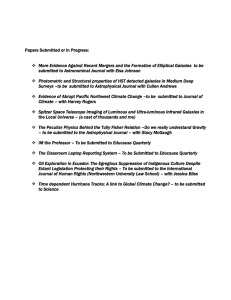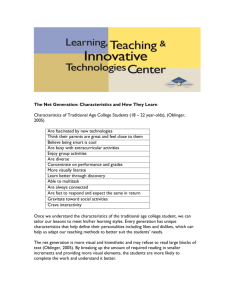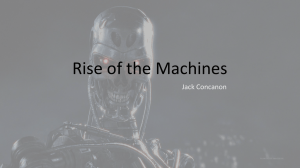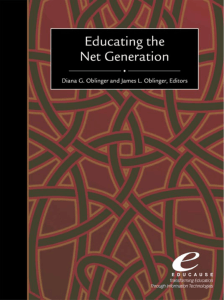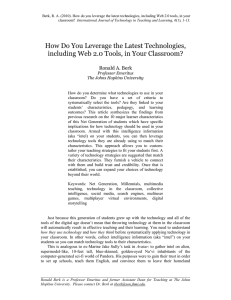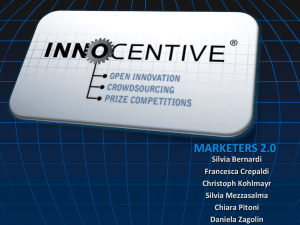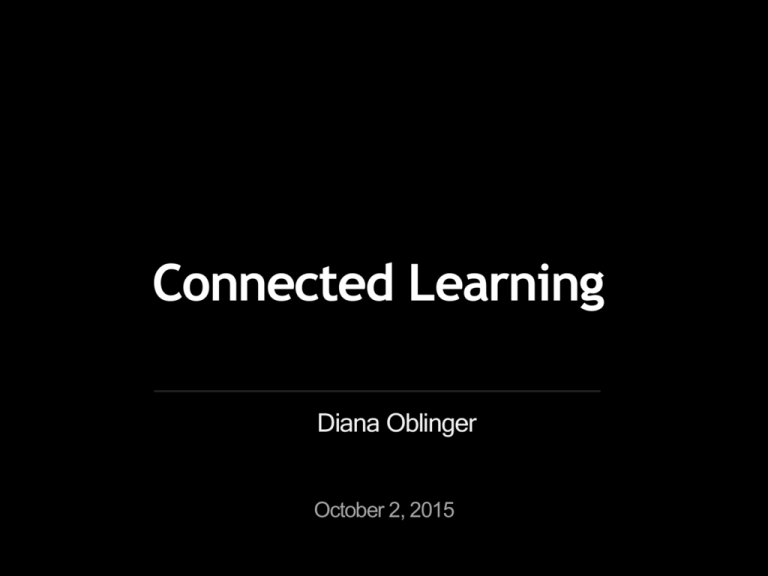
Connected Learning
Diana Oblinger
October 2, 2015
CONSIDER…
Options
Student
Success
Competency
Based Education
Learning
Analytics
Rethinking
Business Models
Data –Driven
Decisions
E-Research
Reinventing
Credits
Consumerized
Expectations
Experiences Matter
The student experience is a critical
differentiator
The Connected Age
Everything (and everyone) is interconnected
The integration of the digital
and physical are creating new
ways to engage.
MENTORED LEARNING
What might happen when
“classic college” meets the
online experience?
Higher order learning comes
from complex challenges.
Experiential
Learning
Spaces
Games as an architecture for engagement
•
•
Games provide a window into the process of learning
Assess skills such as systems thinking, collaboration,
problem solving in the context of subject-area
knowledge
• Situates learning in
complex
information and
decision-making
situations
• Failure is a key to
learning through
games
• Focus on what
users can do
Practice helps develop
expertise.
You Learn to Do
What You Do
TeachLivE
• Mixed reality environment that supports
teacher practice (pre-service and in-service)
• The “classroom” setting is a combination of
real and virtual; students are virtual
characters with a mixture of personalities
• Used to test real-time skills
• Simulations are
interactive
• Data is available for
feedback
• Telemetry can log
breathing, heart
rate, facial
expressions
• Complex
interactions
captured for
feedback and
assessment
The real world offers
many opportunities for
practice.
Disciplinebased
Networks
•
•
•
•
•
Network for Earthquake Engineering Simulation
14 shared-use experimental facilities (e.g., shake
table tests, tsunami wave basin experiments)
Data repository
Interactive earthquake simulation software
Education, outreach and training
Research Experience for Undergraduate Students
Shared national
networks
(collaboratories)
designed to:
• Accelerate
innovations
• Provide access to
expensive tools
• Collect and share
data and resources
• Support learnerbased inquiry
• Enhance
education and
training
Modeling expert practice
develops “identity” and
increases persistence.
Virtual
Internships
Nephrotex
•
•
•
Students play interns in a biomedical
engineering device company tasked to develop a
novel nanotechnology-based membrane for use
in kidney dialysis systems
Students conduct background research, develop
and test prototypes, work with peers, weigh
technical and non-technical factors to propose a
solution
Results show students develop an “engineering
identity” and a more positive view of career
• Simulations that help
students learn to
think like scientists,
scholars, artists, and
workers in the real
world
• Expert mentors
model practice, help
scaffold problems,
and reflect on work
• Connects skills,
knowledge, identities,
values and
epistemology
Low-threshold interdisciplinary
options exist.
Issues-Based
Inquiry
Water 106
•
•
Interdisciplinary, multi-institutional, cross-community
Shared tasks around issues of culture, policy, science
and technology of water
•
Loosely coupled activities require almost no
coordination among faculty
•
Feeding multiple students from multiple disciplines
into the same activity provides awareness of the way
different disciplines look at the same problems
Collection of lowthreshold activities:
• Waterfeed: news
stories and
summaries
• Assignment Bank
• Web TV
• Daily Data
• The Flow: student
reflections and
work posts
Syndicated model
STUDENT SUCCESS
Can clearer pathways improve
learning and student success?
Alternative models focus on
reducing the cost and risk of
education.
Global
Freshman
Academy
Arizona State University
•
•
•
Low cost, low-risk entry point for
college degree
Students can take the classes for no
fee, or—after passing final exams—pay
up to $200 per credit hour
Cost of one year of credit about $4,800,
less than half of regular tuition
• Students do not
have to apply or
be admitted
• 8 freshman
courses available
by MOOCs
• $45 fee to verify
identity
• Can pay to receive
credit once final
grade is received
Data can help students
who are unaware their
success is at-risk.
Predictive
Analytics
•
•
•
Increase student awareness of
class standing and likely outcome
Involve advisors in student success
efforts
Instigate behavior changes; goal is
to teach students how to learn
Guide
interventions
• Pinpoints
problem areas
• Leverages
technology to
empower
students,
advisors, and
faculty
Students benefit from
guided pathways to
success.
Graduation
and
Progression
Success
•
•
•
•
•
Increased semester-to-semester retention
rates by 5%
Reduced time-to-degree by ½ semester
1,200 more students are staying in college
Class of 2014 saved $10M in tuition and fees
Taxpayers saved $5M in support costs
• Georgia State
University
• GPS (Graduation
and Progression
Success) Advising
• Predictive analytics
(by course,
department and
major)
• Student dashboard
• 30% change in degree
conferrals over 5
years
Working learners represent a
sizable opportunity for
increased economic mobility,
equity and growth.
Competency
Based
Education
CBE focuses on assessment of learning,
moving students toward mastery rather
than a grade
• Competencies/skills
demonstrated at
mastery level
• Prior learning and
experience allows
rapid progress
• Continuous formative
assessment
• Personalized learning
dashboards provide a
clear indication of
progress
SERVICE
Can we leverage distributed
knowledge and skills to
improve decisions?
There is no better resource for
improving the world than the
world’s humans.
Crowdsourcing
Volunteer
Efforts
MicroMappers
• Crowdsource the analysis of aerial imagery
captured by UAVs, most recently in response
to the Category 5 Cyclone in the Pacific in
April 2015
• AirVideo Clicker enables quick tagging of
disaster damage in the live videos so
humanitarian and development partners get
access to the analysis in near-real time
• Users identify
images of disasters,
categorize severity
or geo-locate items
• Results are placed
on a map for
damage
assessment and
used by emergency
responders
Volunteers extend research
capabilities, speeding
discovery.
Citizen Science
Galaxy Zoo
• 150,000 galaxies have been identified
• Multiple, independent classifications improve
reliability
• 200,000 online volunteers
• If each classification takes 12 seconds, there
is 500,000 hours of volunteer work,
equivalent to 250 employees working full
time
• Collaborative site
that helps
astronomers classify
galaxies with the
ultimate goal of
understanding how
galaxies form
• Recently discovered
new class of galaxy:
“green pea galaxies”
• Amateur
observations are
used to train
algorithms, further
speeding discovery
Learners provide a good
return-on-investment for
society.
Distributed
ProblemSolving
Innocentive
•
•
•
Challenges issued; 200 prizes awarded
160,000 people from 175 countries
participate
In study of 166 unsolved scientific problems,
49 (or 30%) were solved through Innocentive
• Online
clearinghouse
for scientific
problems
• Releases
untapped
potential by
connecting the
right people
• Solutions often
come from
outside the
expected
discipline
CREDENTIALING
What is the new credentialing
paradigm in a digital
ecosystem?
Certificates and diplomas are
being integrated into online
identities.
DIY Learning
Aggregation service
Online, updatable
service to track and
score learning
Degreed
•
•
•
Tools to help track, organize, validate and
online educational experiences (e.g., Khan
Academy or Lynda.com)
Aggregates content; helps catalog learning
experiences
An average professional’s online learning
time exceeds classroom time
Credit score-like
assessment
Integrates academic,
professional, and
informal
New credentialing systems are
being co-created by educators
and employers.
Microcredentialing
Partnerships between education providers
and employers are creating alternative
credentials aimed at jobholders.
• Coursera
Specializations:
A group of
Personalized
guidance system for:
related
courses and a capstone project
• Well-being
• Udacity
• Work Nanodegree: Online curriculum,
hands-on
learning, community and
• Relationships
coaches
Sounding board allows users to invite others
to advisefor
or comment
Designed
night or weekend study
• A new
credentialing
paradigm is
emerging in the
digital ecosystem
• Connects skills,
credentials, and
employment
opportunities
• Less expensive and
more customized
credentials aligned
with needs of
major employers
Digital portfolios can link
academic achievements to
career success.
Digital
Portfolios
Portfolios help manage and
communicate skills that may include:
• Degrees
• Certificates
• Badges
• Informal learning
Showcase work to
classmates,
instructors and
potential employers
Students can:
• Upload photos,
documents, web
links, videos, audio
and blogs
• Integrate diplomas,
badges, test
scores
Makes learning visible
CLOSING THOUGHTS
The integration of digital and
physical experiences are
creating new ways to engage.
Mentored learning and digital
environments support
complex learning for a
complex world.
We can empower more
learners to achieve their
potential.
Diana Oblinger
doblinger@educause.edu
© 2015 All rights reserved
Slide 3: adapted from Gartner, 2014
Slide 6: image from https://www.flickr.com/photos/assortedstuff/12171872433/
Slide 10: Anya Kamenetz: Psychometric considerations in game-based assessment; image from
http://www.ign.com/wikis/simcity/Construction_%26_Zoning
Slide 12: http://sreal.eecs.ucf.edu/teachlive/
Slide 12: Image from http://www.language-exchanges.org/; Described in http://www.educause.edu/ero/article/bringing-social-back-moocs
Slide 14: https://nees.org/about/neescomm/fastfacts; image from https://nees.org/resources/4233
Slide 16: http://edgaps.org/gaps/epistemic-games-based-course-to-enhance-womens-interest-in-engineering
Slide 18: http://www.slideshare.net/MichaelCaulfield/water106-whitepaper
Slide 22: https://www.insidehighered.com/news/2015/04/23/arizona-state-edx-team-offer-freshman-year-online-through-moocs
Slide 26: Image from http://oie.gsu.edu/files/2014/04/Advisement-GPS.pdf; Bridget Burns, Michael M. Crow, and Mark P. Becker. EDUCAUSE Review,
vol. 50, no. 2 (March/April 2015). Innovating Together: Collaboration as a Driving Force to Improve Student Success.
Slide 28: Image from page 145 in From Teaching in a Digital Age, Tony Bates, 2015. http://opentextbc.ca/teachinginadigitalage/ Citation from Bridget
Burns, Michael M. Crow, and Mark P. Becker. EDUCAUSE Review, vol. 50, no. 2 (March/April 2015). Innovating Together: Collaboration as a Driving
Force to Improve Student Success.
Slide 32: https://irevolution.files.wordpress.com/2014/11/bachelor_thesis_raphael_hc3b6rler.pdf
Slide 34: Comments from Reinventing Discovery by Michael Nielsen; image from www.galaxiezoo.org
Slide 36: last figure from page 84: The Second Machine Age by Erik Brynjolfsson and Andrew McAfee. 2014. Norton & Co.
Slide 40: Jeffrey Young. September 14, 2015. Credit for Watching a TED Talk? http://chronicle.com/article/Credit-for-Watching-a-TED/232973
Slide 42: How Google and Coursera may upend the traditional college degree. 2015. Stuart M. Butler
http://www.brookings.edu/blogs/techtank/posts/2015/02/23-mooc-google-coursera-butler
Slide 44: image with permission from Heather Hiles, Pathbrite

